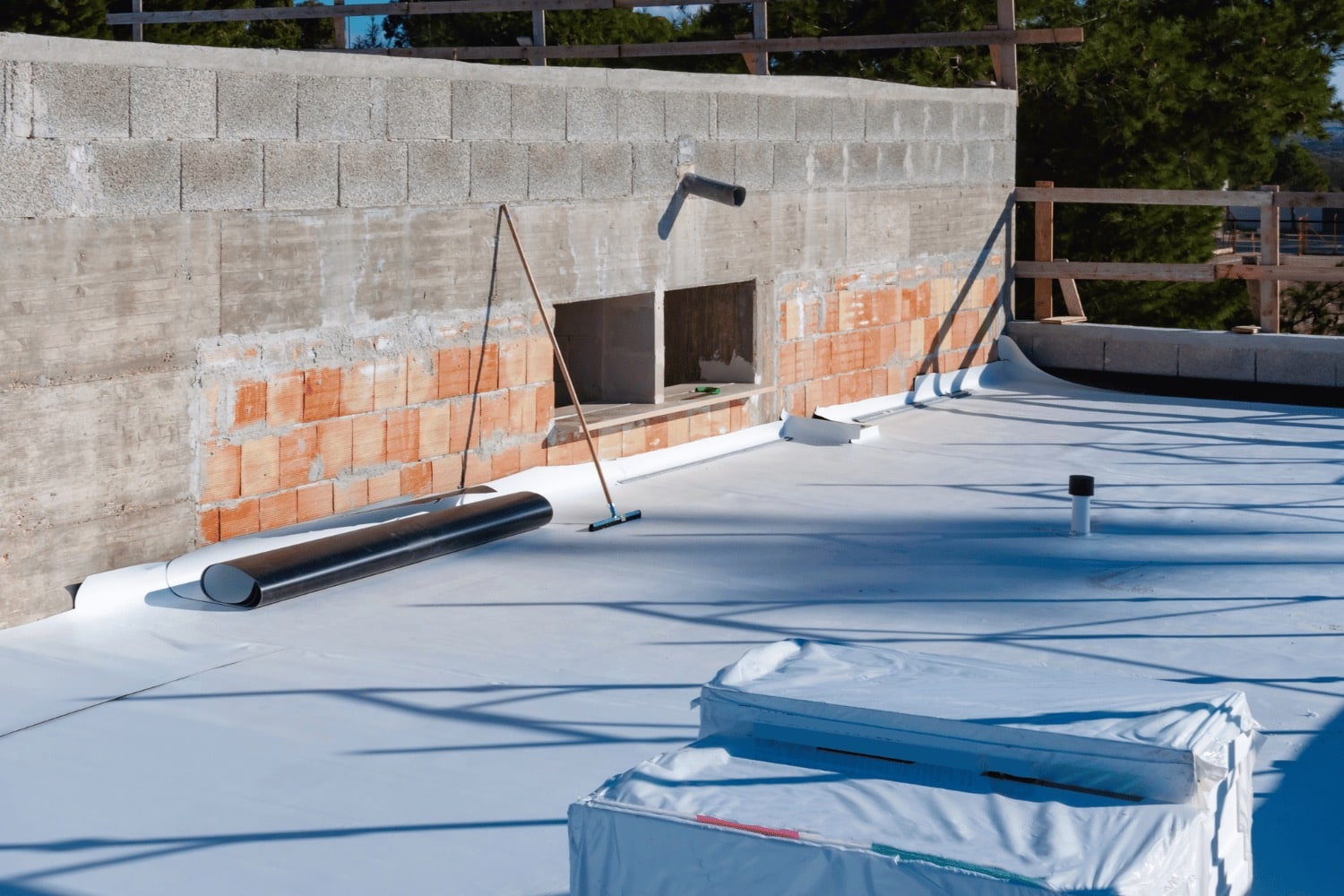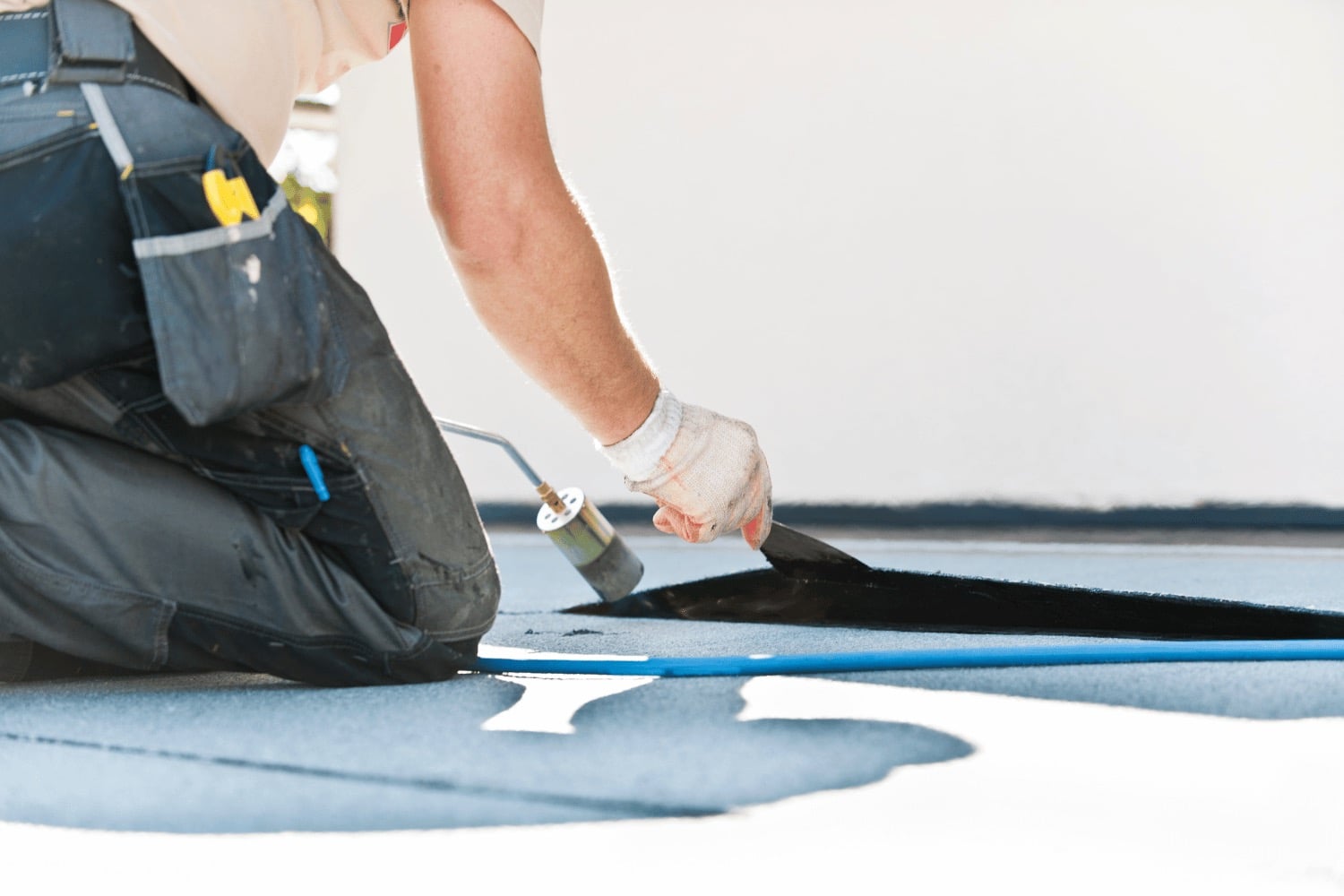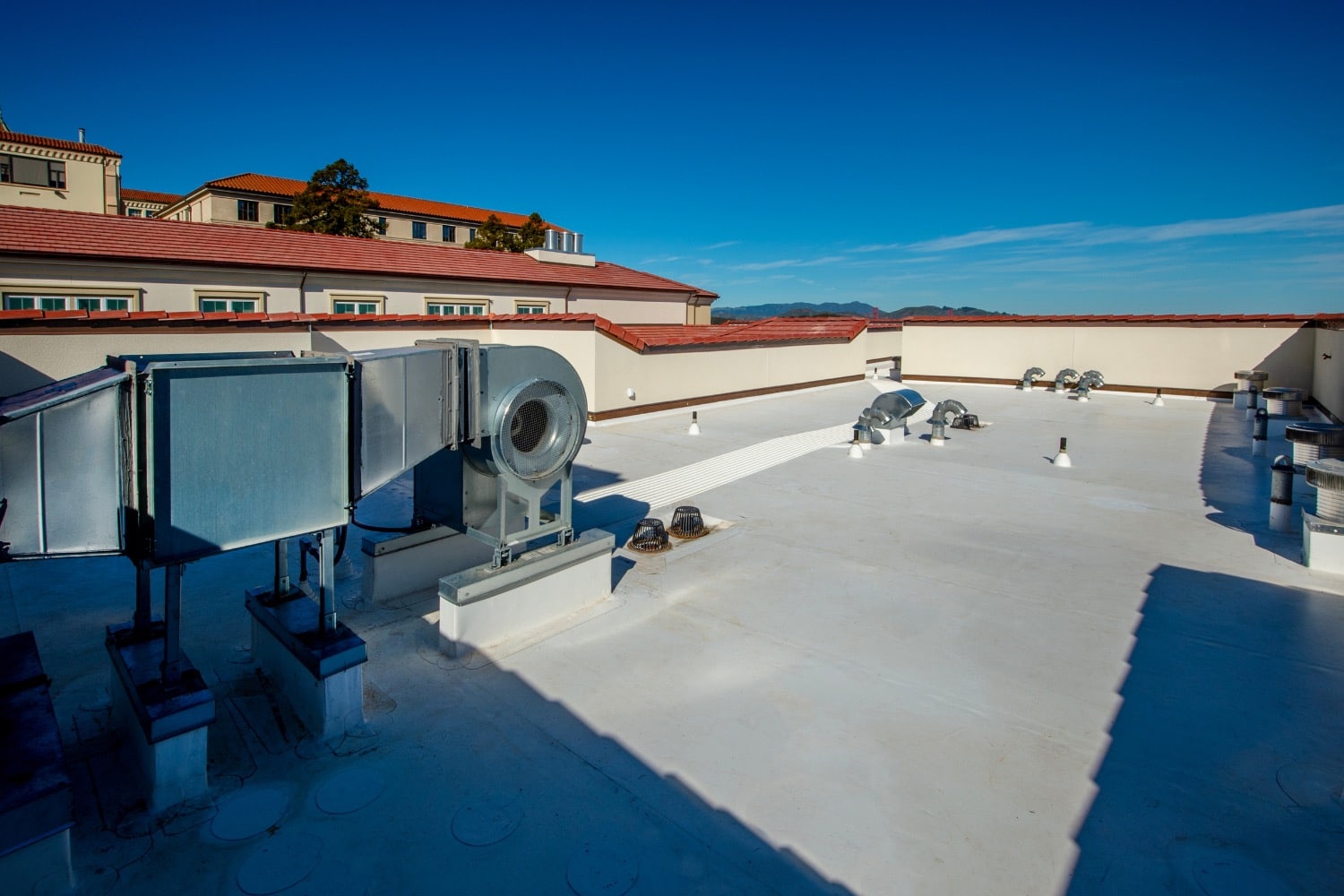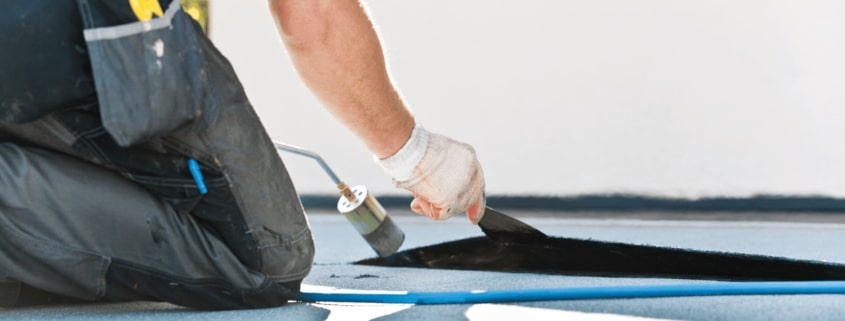Unlocking What Is TPO Roofing: Pros, Cons, and Practical Insights
What is TPO roofing? It’s the energy-efficient and resilient solution increasingly used on flat roofs across commercial and residential properties. Here, we explore TPO’s composition, installation, cost, advantages, and maintenance strategies to give you a comprehensive understanding of this roofing solution.
Key Takeaways
-
TPO roofing is energy-efficient, UV resistant, and environmentally friendly due to its recyclable nature and the absence of chlorine in its formulation.
-
The cost of TPO roofing ranges from $5.00 to $12.00 per square foot, considering materials, insulation, and labor, with long-term energy savings offsetting the initial investment.
-
Regular maintenance is crucial for TPO roofing systems, involving inspections, cleaning, and repairs, particularly at seams, to extend their lifespan and maintain efficiency.
Exploring TPO Roofing: An Overview

TPO roofing, an acronym for Thermoplastic Polyolefin, is a type of single-ply roofing membrane known for its energy-efficient properties. This material is a marvel of modern roofing technology, blending rubbers for flexibility and durability. Its protective qualities and energy-saving potential have made TPO roofing a significant player in the commercial roofing industry.
TPO roofing systems not only shield buildings from the elements but also help save energy, leading to substantial cost savings over time.
Defining TPO Material
Let’s delve into the purpose and properties of TPO material. TPO stands for thermoplastic polyolefin, a blend of polypropylene and ethylene-propylene rubber. Unlike PVC, another common roofing material, TPO has the following properties:
-
It does not contain plasticizers or chlorine salts, giving it a unique level of flexibility.
-
It is resistant to UV radiation and ozone, making it suitable for outdoor applications.
-
It has excellent heat-welding properties, allowing for easy installation.
-
It is environmentally friendly, as it can be recycled at the end of its life cycle.
Moreover, TPO roofing is environmentally friendly since its formulation is free of chlorine, a substance considered harmful to the environment. This unique blend of properties makes TPO a favored choice for both commercial and residential roofing applications.
The Evolution of TPO Roofing Membranes
The United States first introduced TPO roofing in the early 1990s, targeting flat roof structures predominantly. Over the past two decades, its use has steadily increased, reflecting its enduring presence in the roofing industry. The evolution of TPO roofing has seen significant advancements, including the introduction of wider rolls that result in fewer seams, thus creating a stronger and more durable roofing system.
However, despite these advancements, TPO roofing is still considered a relatively new material in the market and is yet to establish a long-standing proven track record compared to other roofing materials, such as traditional materials.
The Anatomy of TPO Roofing Systems

Fundamentally, a TPO roofing system extends beyond a mere single-ply membrane. It is a multi-layered structure, supported by a properly installed solid substrate, which is often an engineered insulation system. The system comprises various elements, including:
-
The TPO membrane
-
Bonding adhesive
-
Cover board
-
Insulation
-
Vapor barrier
-
Underlayment
-
Metal roof deck
The TPO membrane, the heart of the system, is typically attached to the roof deck using mechanical fasteners and plates or adhesive. This multi-layered structure contributes to the system’s energy efficiency and resilience.
TPO Membrane Layers
The TPO membrane, a key component of the TPO roofing system, consists of three distinct layers. It comprises a base layer, a polyester-reinforced fabric center, and a top layer made from thermoplastic polyolefin. The top layer is specifically designed to include UV blockers and abrasion-resistant compounds, ensuring the roof’s resistance to harsh weather conditions.
Additives like talc, fiberglass, and carbon fiber are incorporated into the TPO membrane to enhance its structural integrity and suppleness. Some TPO membranes may even feature a fleece backing to meet specific installation requirements.
Insulation and Underlayment Options
Insulation, pivotal to TPO roofing systems, boosts their energy efficiency. Common materials used for insulation include polyisocyanurate, expanded polystyrene, or extruded polystyrene. Vapor barriers are also used to prevent the escape of interior air, making them particularly valuable in colder climates.
A cover board can be optionally added to TPO roofing systems, serving as a solid surface for membrane attachment and enhancing the roof’s strength and durability. The cost of TPO insulation varies depending on the thickness, making it a crucial factor to consider in the overall cost of the roofing system.
Installation Insights: How TPO Roofs Are Applied
The installation of a TPO roofing system necessitates precision, skill, and specialized tools. Professional roofers use tools like:
-
Heat welders, which are essential for proper TPO installation
-
Bonding adhesive or mechanical fasteners to install the TPO roofing membranes
-
Seam rollers, which press the membrane flat and prevent air bubbles, ensuring a consistent weld
The lighter weight of TPO roofing materials also shortens installation times, leading to potential labor cost savings.
Preparing for TPO Roof Installation
TPO roof installation commences by either removing the existing roof or cleaning the current substrate. Before installing TPO roofing, contractors must ensure the roof deck is clean to avoid any issues during installation.
Ensuring a smooth surface on flat roofs is crucial for the proper adherence and performance of the TPO roofing material.
The Hot Air Welding Technique

TPO roofing installation employs a technique called hot air welding. This technique is recognized for its flexibility, strength, and resistance to UV damage and chemical exposure, essential for the integrity and longevity of TPO roofs. A hot air gun, a key tool in the process, is specifically designed to deliver the heat required to adequately seal the seams of TPO membranes.
The properly executed hot air welding of TPO seams provides robust leak protection, an integral aspect of TPO roofing performance.
TPO Roofing Costs Uncovered
Homeowners and commercial property owners heavily consider the TPO roofing cost when planning for installation. The average total cost for TPO roofing installation typically falls between $7,700 and $14,000. The cost can be primarily broken down into two main components: materials and labor.
TPO roofing materials alone cost between $1.00 and $2.50 per square foot, with additional costs for insulation ranging from $0.50 to $3.00 per square foot. Labor costs to install a TPO roofing system can range from $2.50 to $4.50 per square foot.
Cost-Effectiveness of TPO Roofs
Although the initial outlay for TPO roofing may appear high, one must also take into account the long-term savings. TPO roofing offers the following benefits:
-
Highly energy-efficient, with bright white materials that reflect UV rays and reduce heat absorption, contributing to lower energy costs
-
Over time, these energy savings can offset the initial cost of installation
-
Cost-effective solution for both residential and commercial properties
Price Per Square Foot Breakdown
To give you a better understanding of the cost, let’s break it down per square foot. The total cost to install TPO roofing, combining materials, insulation, and labor, can vary from $5.00 to $12.00 per square foot. These costs also take into account the savings from reduced labor due to the material’s lightweight properties.
With this cost breakdown, you can better estimate the overall cost of your TPO roofing project.
Advantages and Challenges of TPO Roofs
As with all roofing materials, TPO roofing presents its unique advantages and challenges. On the one hand, TPO roofing is designed to be more environmentally friendly, combining the benefits of aesthetics and energy efficiency, with higher UV resistance and lighter colors that reflect heat. However, despite these benefits, TPO roofing can carry drawbacks of being a relatively new product on the market, with risks of seam failure and problems that can arise due to formula variability, leading to premature aging under intense heat and UV radiation.
Additionally, TPO roofing material can be slippery when wet, posing risks during rainy conditions or during maintenance.
Why Choose TPO? Pros of the Material

Several reasons make TPO roofing an attractive choice for your upcoming construction project. Here are some of its benefits:
-
TPO roofing is highly energy-efficient, helping reduce heat absorption and lower energy costs.
-
It is flexible and can be easily installed on different architectural styles.
-
TPO roofing comes in a variety of color options, allowing you to choose the one that suits your preferences.
The benefits of TPO roofing include:
-
Lightweight nature, making it easy to install
-
Availability of large sheets, reducing the number of seams and potential leaks
-
Environmental friendliness, as it is chlorine-free and fully recyclable
These qualities make TPO roofing a popular choice for both residential and commercial projects.
Considerations Before Installing TPO
Nonetheless, it’s vital to understand some potential drawbacks before opting for TPO roofing. TPO roofing systems have been known to experience seam failures and membrane degradation when subjected to excessive heat, UV light exposure, and rapid thermal or solar loading swings.
For TPO roofs with over 25% saturation, the repair options include full removal of the TPO and insulation or installation of a new TPO system, though a spray foam roofing system may be a cost-effective alternative.
Maintenance and Longevity of TPO Roofs

Proper maintenance plays a key role in prolonging the lifespan and enhancing the performance of TPO roofing. Here are some tips to keep your TPO roof in top shape:
-
Regularly inspect your roof for any signs of damage or wear.
-
Clean your roof regularly to remove debris and prevent buildup.
-
Trim tree branches to prevent contact with the TPO roof.
-
Keep gutters clean to ensure proper drainage.
Following these maintenance practices will help ensure optimal performance and durability for your TPO roof.
Uplifted seams on a TPO roof can be repaired to prevent further water entry and potential damage.
Extending Your TPO Roof’s Life
Regular maintenance is integral to prolonging your TPO roof’s lifespan. The roof should be cleaned of debris and washed regularly with a detergent using a low-power pressure washer and a soft-bristle broom to avoid damage.
Such practices, coupled with the inherent durability and energy efficiency of TPO roofs, can lead to fewer repair costs and a longer lifespan, making TPO roofing a cost-effective solution in the long run.
Signs of TPO Wear and Tear
It is essential for homeowners to regularly inspect their TPO roofs for any signs requiring maintenance attention. Visible damage on TPO roofs, such as cracks, punctures, or discoloration, should be noted as potential indicators of the need for repair or replacement. TPO roof seams are critical areas that require close examination for any signs of pulling apart or weakening, as they are essential to the roof’s watertight integrity.
Particular attention should be paid during inspections to the transitions between the TPO membrane and other roof parts, as these interfaces are potential areas for wear or damage.
Rapid Roofing’s Expert Approach to TPO Solutions
With over 30 years of industry experience, Rapid Roofing, a leading Ann Arbor roofing company, specializes in TPO roofing solutions. With a history of thousands of completed jobs and multiple offices enhancing their reach and accessibility for homes and businesses, Rapid Roofing stands as a beacon of reliability and expertise in the world of TPO roofing.
Rapid Roofing, a proud member of the National Roofing Contractors Association, not only specializes in TPO roofing solutions but also offers a broad spectrum of services as a reliable roofing contractor, emphasizing rapid installations and customer service that exceeds expectations.
Our Lifetime Warranty Promise
Our lifetime warranties distinguish Rapid Roofing from others. Reflecting our dedication to providing quality and durability in our roofing services, we offer lifetime warranties on all TPO roofing projects.
This guarantees long-term performance and peace of mind for our customers, assuring them that their investment is protected for the long haul.
Financing and Insurance Assistance
We at Rapid Roofing acknowledge that roofing projects can entail a substantial investment. That’s why we provide financing assistance through flexible programs, including options with Michigan Saves for which we are an authorized contractor. Customers can take advantage of various financing options, including plans with low or no initial down payment and the option to spread payments over 60 months.
We also offer specialized support when handling insurance claims, aiding in the documentation and steps required to maximize reimbursement after emergencies like fires or storms.
Summary
In conclusion, TPO roofing stands as a viable choice for both commercial and residential roofing applications. Its energy efficiency, durability, and environmental friendliness, coupled with its flexibility and aesthetic appeal, make it a popular choice in today’s construction industry. While there are considerations to keep in mind, such as potential seam failures and wear and tear, regular maintenance and proper installation techniques can help mitigate these issues. The expert approach of Rapid Roofing, with our lifetime warranties and financing assistance, ensures a seamless and satisfying TPO roofing experience.
Frequently Asked Questions
What is TPO roofing and why is it popular?
TPO roofing is popular due to its energy-efficient properties and blend of rubbers that offer flexibility and durability, making it a popular choice in the commercial roofing industry.
How is TPO roofing installed?
TPO roofing is installed using bonding adhesive or mechanical fastening, and hot air welding is a key technique for ensuring durability. It requires expertise and specialized tools.
What are the cost factors involved in TPO roofing installation?
The cost factors involved in TPO roofing installation include material costs ranging from $1.00 to $2.50 per square foot, insulation costs from $0.50 to $3.00 per square foot, and labor costs from $2.50 to $4.50 per square foot. These factors should be considered when budgeting for the installation.
What are the advantages and challenges of TPO roofs?
TPO roofs provide environmental friendliness, energy efficiency, and aesthetic appeal, but they may have potential seam failures and premature aging due to formula variability under intense heat and UV radiation. Be mindful of these challenges when considering TPO roofing.
How can the lifespan of TPO roofs be extended?
To extend the lifespan of TPO roofs, it’s important to regularly clean debris and conduct inspections to identify signs of wear and tear that need attention. Regular maintenance is key to ensuring longevity for TPO roofs.






